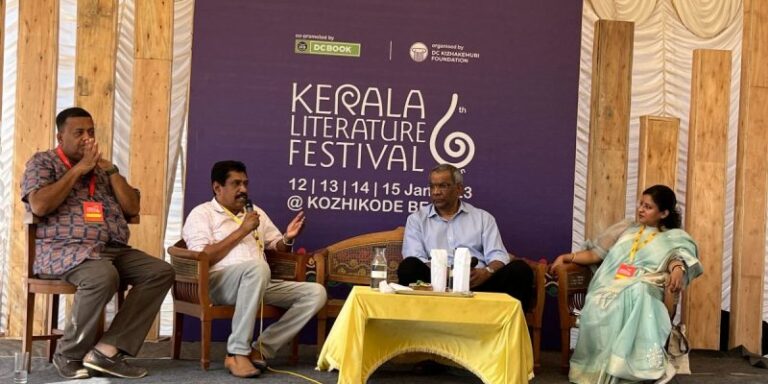Kozhikode: In a country where languages change every few hours you travel, can literature be a binding force? And what role does translation play in bringing those worlds together?
At a session on the Sunday (January 15), the final day of the Kerala Literature Festival, three publishers – David Davidar of Aleph Book Company, Aditi Maheshwari Goyal of Vani Prakashan and Ravi Deecee of DC Books – and an author – V.J. James – discussed the ins and outs of publishing translations in India.
“India is one of the most interesting and most challenging landscapes when it comes to publishing translations,” Davidar said, “and that is because of the number of languages we have.”
James, who writes in Malayalam but has seen several of his books translated into English, said that being published in English opened his work up to audiences he did not think he would have access to. “Social media has also played a role in making translations more popular. People will read a book and then post about it – and others, who may be living in different contexts, will see that and get interested.” There is more cross-cultural reading, he believes, because of ordinary readers having a space to discuss books with people from different places.
Goyal lamented the fact that translation networks in India do not exist as they should. Instead, it is often informal relationships between people in the publishing industry that leads to books being translated – which may not be representative of all the books the country is producing.
Vani Prakashan publishes in Hindi – both original work and translations.

Some books on the Vani Prakashan catalogue. Photo: https://vaniprakashan.com/
“Language cannot grow in its own vacuum,” Goyal argued. “It has to learn and borrow from other languages, that’s how communication begins. …Translation then becomes very important in a country like India. But unfortunately, no Europe-like model exists here to streamline and bring together literature from different parts of the country. There are national bodies that were supposed to do this, but instead they are only functioning as publishers.”
This means, she continued, that there is no formula for discovering new books. “Discoverability remains a challenge; we depend on our friends and advisors. Something like a cooperative of publishers, which Ravi [Deecee] sir and I have been discussing, could perhaps help smooth things over.”
It is true, however, Deecee argued, that the situation today is somewhat different – there is an increasing interest in, and recognition for, translated works. “I was surprised by the JCB Award when it was first announced [which goes to Indian fiction written in English or translated into English], but fortunately our translators have lived up to the challenge – books written in English and translated into English can stand side by side. This has changed in the last five-ten years – with the industry growing, the quality of translation too has increased.”
At another session at the festival on Saturday, Radhika Menon of children’s book publisher Tulika Books also made the point that the way we look at publishing – particularly publishing in different languages – has changed over the years. Tulika’s first book Ekki Dokki by Sandhya Rao, published 26 years ago, was bilingual (English and Hindi) – and at the time, that was seen as a radical decision.

‘Ekki Dokki’, Sandhya Rao, Tulika Books.
“The National Book Trust would publish in Indian languages, but this was the first bilingual book. For us, that seemed completely natural in a country like India, where most children grow up surrounded by multiple languages. Learning a new language by relating it to one you already speak then seemed very logical. But everyone – even schools – told us it wouldn’t work, that we should stick to one language.”
Translators, too, believe the landscape has changed – and three Kannada translators discussed these changes at the opening session of the festival on Thursday.
Pratibha Nandakumar, an acclaimed poet, journalist and translator, said as the industry has grown, the kinds of books being translated has also become more diverse.
“I only translate the books that I find interesting, that resonate with me in some way. And I’m sure other translators too decide in the same way, because it is very difficult to build a relationship with a text you cannot connect to. So the more people there are making these decisions, the more different kinds of books will be translated.”
What needs further conversation, though, is the kind of recognition and compensation that translators receive – whether as one-time payment or a percentage of royalties.
“More publishers are now featuring translators’ names on book covers, which is a positive development,” writer and translator Deepa Bhasthi said. “In terms of both compensation and recognition, I think all stakeholders – authors, translators and publishers – need to be involved in the conversation to come up with a more fair system.”



